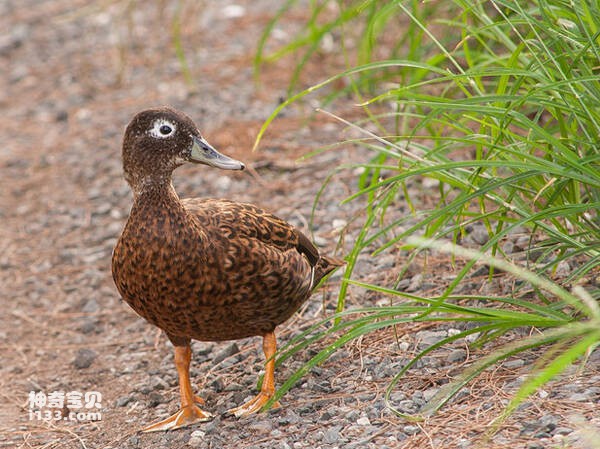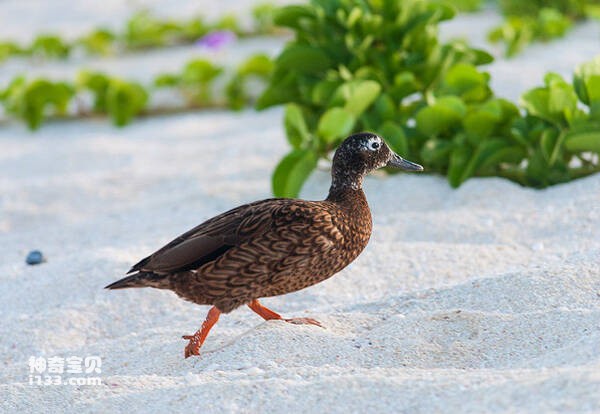Anas laysanensis
IUCN
LCBasic Information
Scientific classification
- name:Anas laysanensis
- Scientific Name:Anas laysanensis,Laysan Duck
- Outline:Waterfowl
- Family:
Vital signs
- length:About 41 cm
- Weight:447-451g
- lifetime:About 12 years
Feature
Their beaks are short and flat with black spots
Distribution and Habitat
The Lae duck is a medium-sized water duck endemic to the Hawaiian Islands. It is found only on Laysan Island in the Hawaiian Islands.
Most adult ducks hide in dense terrestrial vegetation during the day, especially during the breeding season, in the grass and jungle to avoid predation by birds of prey. It can occur in the high salinity of Lake Lesanne. They are also found in freshwater lake areas around the coast, and generally young ducks are active in lower salinity waters.
Appearance
The Lae duck is 41 cm long, weighs 447 grams for females and 451 grams for males, and lives for 12 years. The overall color is dark brown with white eye rings. Their beaks are short and flat with black spots, the male has a dark green beak, and the female has a brown-orange beak. Some male ducks have a green rainbow on the head and neck, with a slightly upward central tail feather.
Both male and female ducks have purple and green wing mirrors. The whole body is covered with white markings. The head and neck feathers of old ducks may turn white. The feet are orange, and the male's are brighter. Every year they lose their whole body, and they lose their flight feathers and do not know how to fly until new ones grow.
Details
The Laysan Duck (Anas laysanensis), formerly a subspecies of the mallard duck, was classified as a separate species in 1987.

Lae ducks are most active in the morning and evening, but are also adjusted by food availability. The Lai Island duck is highly capable of flying and can reach as far as the Chinese island of Taiwan and beyond, but it is more suitable for walking and its pelvis is well constructed for living on land. Rest at noon and forage for food in the evening and at night. They keep their beaks close to the ground along the mud flats and open them to eat the flies. They also burrow into shallow lakes and coasts, foraging in upland jungles for invertebrates, algae, leaves, and seeds.
The breeding season of the Lae duck extends from spring to autumn, usually from April to August, mainly June. Mating takes place on land or over water and consists of female ducks building a bowl-shaped nest of leafy grass and feathers under dense vegetation. Four eggs are laid at a time, and incubation takes 40-60 days. The ducklings are able to forage on their own the day after hatching, guided by the female.

The Lae duck is endemic to the Hawaiian Islands in the United States, and fossil remains show that the species was once common in the Greater Hawaiian Islands, and the species is endangered. At the beginning of the 20th century, due to drought and disease, the population dropped to 82-127, and then increased to 500, peaking at 743. Since 2010, the population has been estimated at 521. Actions taken to protect the Lae duck include habitat restoration, restoration or enhancement of limited freshwater habitat in the Hawaiian Islands for brooding, stabilization of sand dunes and planting of vegetation to prevent accidental invasion of competitor and enemy species, especially new species of ants and rats. The predators were moved out, and the Lae ducks were introduced into the lowlands of Midway and Lae SAN for artificial conservation. Kahoolawe Island has been proposed as a new environmental area for Lae ducks with good introduction and habitat recovery.
Listed on the International Union for Conservation of Nature (IUCN) 2012 Red List of Threatened Species ver 3.1 - Critically Endangered (CR).
Listed in the Washington Convention CITES Class I protected animals.
Listed in Appendix I, Appendix II and Appendix III of the Convention on International Trade in Endangered Species of Wild Fauna and Flora (CITES) 2019 edition.
Protect wild animals and eliminate wild meat.
Maintaining ecological balance is everyone's responsibility!








